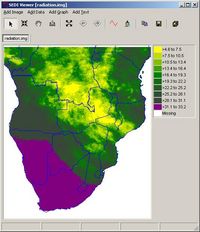(Difference between revisions)
| Revision as of 09:58, 25 July 2006 Peter (Talk | contribs) ← Previous diff |
Revision as of 09:59, 25 July 2006 Peter (Talk | contribs) Next diff → |
||
| Line 40: | Line 40: | ||
| | Palace of Westminster || [[Image:Westminstpalace.jpg|thumb|none|100px|From the Thames]] | | Palace of Westminster || [[Image:Westminstpalace.jpg|thumb|none|100px|From the Thames]] | ||
| |---- | |---- | ||
| - | | Buckingham Palace || [[Image:Buckingham palace Copyright2003KaihsuTai.jpg|thumb|none|100px|Queen's home]] |} | + | | Buckingham Palace || [[Image:Buckingham palace Copyright2003KaihsuTai.jpg|thumb|none|100px|Queen's home]] |
| + | |} | ||
Revision as of 09:59, 25 July 2006
Introduction to GIS and formats
GIS
In order to work effectively with large quantities of data the use of geographic information systems (GIS) is necessary.
Geographic Information Systems (GIS) are a computer programs that organize, display, and analyze spatially distributed data. At its simplest, GIS is "mapping", providing a geographic arrangement of extremely diverse information. GIS has been applied in geology, biology, psychology, anthropology etc., and has been around in Crop Forecasting for a long time.
General purpose GIS programs are designed to capture and analyze any kind of geographical data. The most common commercial GIS software packages worldwide are:
However the open-source community has created a wide range of free tools (to be downloaded from the internet). A nice start page can be found here: http://www.mapcruzin.com/free_gis.htm
Data
GIS data is commonly in one of two forms:
- Raster or image format. A grid of rows and columns of cells. These might represent photographic or scanned images. Within agrometeorology satellite images are usually represented in this way. Each cell represents a value. This value can be assigned a thematic colour in order to visualize the data. Raster data come in a large number of file types. A good overview of raster file types can be found here: http://data.geocomm.com/helpdesk/formats.html#raster-formats
- Vector format. Geometric shapes, including points, lines, and polygons. These might represent buildings, roads, and counties. This link gives sums up the most commonly used general purpose vector formats: http://data.geocomm.com/helpdesk/formats.html#vector-formats
Data types used in crop forecasting.
Besides the above-mentioned file types, crop forecasting has its own file types. This has developed over the years, mainly because low-cost GIS systems did not exist at the time most early warning systems were set up. The most important file types are:
- Image data in IDA (Image Display and Analysis) format. The IDA image file consists of a 512 byte image header followed by unblocked (raw binary) image data, 1 byte per pixel, beginning at the top-left of the image and processing row by row. This means that the size of an IDA image in bytes can be expressed as 512 + (lines*pixels). An image that is 150 lines high and 234 pixels wide will have an image size of 35612 bytes. This provides an excellent check whenever images seem to be distorted. A more detailed description of the IDA image format.
Display an IDA image in Agrometshell using the View-Image function.
Display an IDA image in Agrometshell using the View-Image function. Palace of Westminster Buckingham Palace
- Vector data in BNA format. This format has been developed by a company (Atlas GIS) for data exchange purposes. It is a simple ASCII format. The format allows the definition of points, lines and polygons, the three basic vector entities. See an example of a BNA File.
- FAO format. This format has been introduced by FAO to display data in columns and rows. See an example of a FAO format File.




